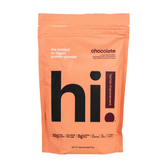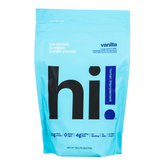The big takeaways:
Don’t worry about taste or texture! Cricket protein powder is smooth and nearly flavorless, most closely resembling the nutty flavor of almonds or cashews.
Most crickets offer a complete protein solution with around 60 to 75 grams of protein per 100-gram serving.
Cricket protein powder is one of the most nutrient-dense protein sources on the planet with iron, fiber, magnesium, prebiotics for gut health, healthy fats, and vitamins and minerals such as calcium, iron, potassium, vitamins A, C, D, E, K, and more.
Crickets are one of the most sustainable sources of protein in the world. Emitting 99.9% less Greenhouse Gasses than livestock protein and using a fraction of the land, water, and resources. This makes them the ideal sustainable food source for a growing global population.
We get it, the idea of eating crickets might sound new to you. However, for 2 billion people on the planet today it’s the top protein choice for nutrition and sustainability. Outside of the United States, insect protein has been part of traditional cultures all over the world for thousands of years. Over 2,000 species of insects are used for food across Asia, Africa, Latin America, and other parts of the world today.1,3 Maybe the idea of cricket protein isn’t all that “new” after all. Maybe, we’re just behind.1,2
Crickets are one of the most sustainable and nutritious sources of protein in the world. They contain more protein than cows, chickens, and pigs while helping to save the planet in the process with a much smaller environmental footprint.1
The easiest way to try cricket protein for the first time is in a powdered format that can either be baked or blended into beverages like a smoothie or shake. People are constantly surprised by how little they can notice the taste because as a protein powder, cricket is nearly flavorless.
When it comes to texture, people are usually also surprised by how smooth this protein is compared to the chalky taste of other protein powders.
Recent studies show that once you try cricket protein powder and feel how your body responds to the increased energy and health benefits, there’s a good chance you’ll never go back to your old protein powder.
What does it taste like?
The cricket protein in Human Improvement Protein Powder is almost flavorless. It has a slightly nutty taste which most closely resembles almond or hazelnut.
And we’ve paired our cricket protein with coconut milk, flaxseed, cocoa powder, and pink Himalayan salt for a delicious and irresistible blend that’ll make you forget all about cricket in the first place.
Why eat cricket protein powder?
There are endless reasons to introduce this superfood into your diet. The simplest answer is: cricket protein is better for your body and our planet.
When it comes to your body, here’s how cricket protein works to keep you healthy from the inside out:High protein content?
Cricket protein has an equal or higher protein content than most other protein sources.1 In a 100 gram serving of cricket protein, you’ll find around 60 to 75 grams of protein depending on the species.4 To give you a comparison, beef has 43 grams and chicken 31 grams for the same amount.4,5
Not only is cricket high in protein, but it’s also a complete protein. This means they contain all nine of the essential amino acids that your body needs.6 They’re essential because your body cannot produce them naturally, meaning you have to get them from your food. But unlike other animal-based complete protein sources, you’re not just getting a high amount of protein but an incredible lineup of nutrition.
.
Nutrient-dense
Cricket protein powder is one of the most nutrient-dense protein sources on the planet. They’re high in fiber and healthy fats and packed with nutrients including calcium, potassium, zinc, phosphorus, magnesium, manganese, copper, and iron.1,2 They’re also incredibly high in folic acid, pantothenic acid, vitamins A, C, D, E, K, biotin, riboflavin, and other B vitamins.1
Their iron, calcium, zinc, manganese, and B vitamin levels are higher than most other meat-based protein sources such as chicken, pork, and beef.1,7 One study even found that the iron content of crickets is 180% higher than that of beef and two times higher than spinach!7 As for vitamin B12, they contain 150% of your recommended daily value, which helps to increase your energy and mood.
And unlike the high content of unhealthy saturated fats in red meat, crickets provide a high amount of healthy monounsaturated and polyunsaturated fatty acids.1 These healthy fats are great for your heart, even possibly reducing your risk for heart disease.1
Lots of healthy fiber
The high-fiber content of crickets is also unique. In a 100-gram serving of cricket, you can have as high as 13.4% fiber, while other meats are lacking.1 Your body needs fiber for healthy digestion, and most Americans don’t get nearly enough. Fiber is a healthy complex carbohydrate that supports your body’s digestion, regulates your blood sugar levels, and keeps you feeling full for longer.11,12 Americans are in what’s called a “fiber gap” because over 90% of adults don’t get nearly enough fiber in their diets.13 A diet low on fiber could lead to weight gain, exhaustion, constipation, low blood sugar levels, and other digestive issues.14 Thanks to the high fiber content of cricket protein and our other nutrition-packed ingredients, Human Improvement has over 5g of healthy fiber per serving which helps close the door on that fiber gap.
Easy to digest and supports gut health
Crickets also contain prebiotic fibers like chitin and chitosan that help keep your gut microbiome healthy. Your gut contains live microorganisms that help support your digestion, immune system, and overall health. Prebiotic fibers like chitin and chitosan help feed those tiny organisms working hard to maintain your gut health.
In one study, they found that consuming 25 grams of cricket protein powder per day for two weeks led to an increase in healthy gut bacteria and reduced inflammation.8 With cricket protein, you can help reduce bloating, constipation, and other uncomfortable digestive issues while also improving your body’s defenses against infection.8 These fibers also make Human Improvement Protein powders super easy to digest, meaning you’ll feel good while supplying your body with the fiber it needs for healthy digestion. These prebiotic fibers cannot be found in plant or whey protein, which is one of the reasons why whey is so hard to digest.
Environmentally friendly protein alternative
Beyond helping our bodies, cricket protein is also helping to save our planet. Crickets are an incredibly sustainable protein source. This means that they’re not just good for you, but good for the planet too. Agriculture currently contributes over one-third of all greenhouse gas emissions (GHG.)4 That’s more greenhouse gasses than all forms of transportation combined!2 And animal-based food production accounts for more than 75% of that global agriculture.2 Insects, on the other hand, use far less land, water, and resources than conventional livestock farming. They need six times less feed than cattle, four times less than sheep, and two times less than pigs and chickens to produce the same amount of protein.9 And they release 80 times fewer greenhouse gasses than cows.4
Where do the crickets come from? Our crickets come from the only organic cricket farm in North America. The facility is located outside of Toronto and is a BRC food safe certified facility. They are minimally processed to maintain all the vitamins, minerals, and nutrients in the cricket.
Why do we need sustainable protein?
Does sustainable protein matter and will it make a difference? The answer to both questions is “yes.” The biggest impact you could ever have on our planet is not with the car you drive or the straws you use, it’s what you put on your plate. By 2050 we’re projected to have close to 10 billion people on this planet and our food production will need to double as a result.2,10 This is a problem because we’re already struggling to provide enough food for our global population, with nearly 1 billion going hungry today.2 As we mentioned, animal-based food production accounts for more than 75% of all global agriculture. Yet, it uses up the most resources — like 70% of our freshwater — while only contributing 37% of the protein.2,11 The top researchers and scientists in the world have concluded that one of our best hopes for the planet and our growing population is edible insect protein. Here’s a quote from researchers at the Food and Agriculture Organization of the United Nations: “Insects as food and feed emerge as an especially relevant issue in the twenty-first century due to the rising cost of animal protein, food and feed insecurity, environmental pressures, population growth, and increasing demand for protein among the middle classes. Thus, alternative solutions to conventional livestock and feed sources urgently need to be found. The consumption of insects, or entomophagy, therefore contributes positively to the environment and to health and livelihoods.” It’s what they call the “Great Food Transformation” or the move to more sustainable agriculture.10 Because insects need far less land and resources to provide the same amount of protein, they are the most trusted solution for our future. Another recommendation made in the “Great Food Transformation” is for more plant-based food sources. This graph from the World Resources Institute below shows how plant-based proteins — like the ones found in our Human Improvement Protein Powders — emit far fewer greenhouse gasses (orange bar) while needing less rainwater (blue bar) and land (green bar) than animal-based foods.10
When you check out this graph from the Food and Agriculture Organization (FAO), you can see that beef and pigs produce far more greenhouse gases than some of the most popular edible insects.

Image source: FAO
The same goes for animal vs. plant-based food sources. In this graph from the World Resources Institute, beef generates about five times more greenhouse gas emissions than chicken and over 30 times more than wheat or rice.
Image source: World Resource Institute
Improvement Tip: If you’re getting just as jazzed about sustainability as we are, check out this chat we had on Instagram with political educator, environmental activist, and podcast host Kate Glavan for more ways to approach sustainability. If you care about the planet and want to hear more details on practical sustainability tips, listen to our interview with political educator, environmental activist, and podcast host Kate Glavan.
Why we use cricket protein in our protein powder
Our team at Human Improvement was searching for “a better way to protein” — one that was better for our bodies and planet.
As we started looking, we rediscovered a forgotten superfood that is one of the most sustainable and nutritious sources of protein in the world. The problem is, we knew people (including ourselves) would be skeptical of this not-so-new ingredient: cricket protein.
We see cricket protein as a gift from nature that can help us with our health and the health of our planet. However, we also understand that there are a lot of stigmas associated with insects as ingredients in our culture.
To introduce this product, we knew it had to taste better, look better, and make people feel better than any other protein powder out there.

That’s why we decided to reimagine protein powder to create “a better way to protein”:
- Better ingredients: We use just 13 simple, nutrient-dense ingredients and did away with the gums, fillers, gut irritants, and added sugars that are in many other protein powders. View our complete ingredient list with benefits here.
- Better taste: We chose each ingredient to create naturally delicious flavors with smooth textures. Light and refreshing, never overly sweet or chalky.
- Better for your gut health and digestion: The first protein powder specifically designed to not cause bloating. Our protein blends combine the benefits of prebiotics and plant fiber to support gut health and easy digestion.
- Better experience: Our protein is delivered in conveniently portioned recyclable packets. Our sustainable packaging uses 90% less plastic than traditional plastic tubs. So you can stay healthy and sustainable on the go.
- Better for the planet: A new superfood that's one of the most sustainable sources of protein in the world, cricket protein. Learn about the benefits for your body and planet here.
If you’re ready to join the improvement movement, order your first box of cricket protein powder today and check out the Museum of Smoothies for delicious and healthy recipes for adding Human Improvement into your daily routine.
Sources












